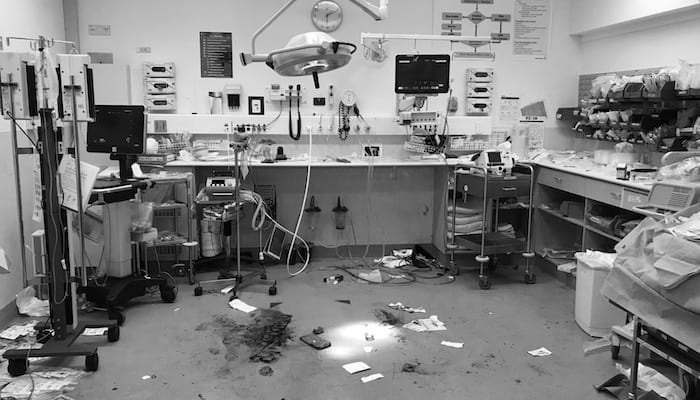He simply looks sick…
aka Ruling the Resus Room 001
A 60 year-old man is brought into the emergency department because he has felt unwell the past 5 hours. He is awake, diaphoretic and ‘looks sick’. He is mildly tachycardic, mildly tachypneic and afebrile with a blood pressure of 100/60 mmHg. His blood glucose is normal. There is no history of trauma.
Clearly this man needs a bit of work — he looks sick with abnormal vital signs. So… Now what?
Inspired by a talk by Amal Mattu on ‘The Crashing Patient’
Questions
Q1. What are your initial actions?
Answer and interpretation
Initial actions, after assessing the ABCs, should include:
- Manage in a resuscitation area
- Get help
- Administer high-low oxygen via a non-rebreather mask
- Attach monitoring/ defibrillator — SpO2, RR, ECG, BP
- Obtain large bore IV access (2 big peripheral lines) and take bloods
- Perform a 12-lead ECG
Blood glucose has already been checked.
“Somewhere between ABC and CBC, [there’s scope to] lose a lot of patients…”
— Amal Mattu
The ECG shows a mild sinus tachycardia and ‘non-specific’ T wave changes. The patient still looks sick. A bag of normal saline is hanging. Nothing much has changed.
Q2. What is most useful thing you can do at the bedside do figure out what to do next?
Answer and interpretation
Perform bedside ultrasound.
In particular look for a pericardial effusion and check for an aortic aneurysm. About half of aortic emergencies present without chest or back pain and simply ‘look sick’. Abdominal ultrasound can often easily identify an abdominal aortic aneurysm and pericardial tamponade is a common mechanism of death in aortic dissection. Ultrasound can also diagnose tension pneumothorax, potential causes of hypovolemia, effusions and cardiac failure.
“’Classic presentation’ means it occurs 15% of the time.”
— Amal Mattu
Unfortunately, while you are thinking about Q2, the patient has a PEA arrest.
Q3. What is the resuscitation algorithm for a PEA arrest?
Q4. Should you thrombolyse this patient?
Answer and interpretation
Thrombolysis is often suggested as myocardial infarction and pulmonary embolism are common causes of a PEA arrest.
By all means, get ready to administer thrombolytics but consider other causes of PEA arrest first. As part of this do the bedside ultrasound — arrests from aortic emergencies also commonly result in PEA. Needless to say, thrombolysis won’t do these patients any favours…
Q5. What are the causes of PEA?
Answer and interpretation
Remember the 6Hs:
- Hypovolemia
- Hypoxia
- Hydrogen ions (acidosis)
- Hyperkalemia or hypokalemia
- Hypoglycemia
- Hypothermia
and the 6Ts:
- Tablets and toxins
- Tamponade (cardiac)
- Tension pneumothorax
- Thrombosis (myocardial infarction)
- Thrombosis (pulmonary embolism)
- Trauma
Note that this commonly used memory aid doesn’t include:
- aortic emergencies —see Die Like A King
- dynamic hyperinflation
In this case, bedside ultrasound shows a pericardial effusion and a dilated aortic root.
“Every time you see a sick patient, perform bedside ultrasound. Look at the heart, look at the belly. You will save lives.”
— Amal Mattu
Q6. Based on the answer to Q5, what should you do next?
Answer and interpretation
Put simply, the next steps are:
- Continue effective CPR — don’t stop!
- Urgently notify the on-call cardiothoracic surgeon, or arrange transfer to an appropriate center.
- Emergency drainage of the pericardial effusion to correct the pericardial tamponade (preferably ultrasound guided).
- If there is ‘return of spontaneous circulation’, initiate post-resuscitation care.
Don’t let the patient die like a King.
“The aorta is a ticking bomb, a grenade waiting to go off.”
— Amal Mattu
References
- Kurimoto Y, Morishita K, Narimatsu E, Asai Y, Abe T. Satisfactory recovery after 45 minutes of resuscitation in acute aortic dissection. Crit Care Med. 2002 Sep;30(9):2030-1. PMID: 12352036.
- Mattu, A. ‘The Crashing patient‘ — Free Emergency Medicine Talks.
- Meron G, Kürkciyan I, Sterz F, Tobler K, Losert H, Sedivy R, Laggner AN, Domanovits H. Non-traumatic aortic dissection or rupture as cause of cardiac arrest: presentation and outcome. Resuscitation. 2004 Feb;60(2):143-50. PMID: 15036731.

CLINICAL CASES
Resus Room Reflection
Chris is an Intensivist and ECMO specialist at The Alfred ICU, where he is Deputy Director (Education). He is a Clinical Adjunct Associate Professor at Monash University, the Lead for the Clinician Educator Incubator programme, and a CICM First Part Examiner.
He is an internationally recognised Clinician Educator with a passion for helping clinicians learn and for improving the clinical performance of individuals and collectives. He was one of the founders of the FOAM movement (Free Open-Access Medical education) has been recognised for his contributions to education with awards from ANZICS, ANZAHPE, and ACEM.
His one great achievement is being the father of three amazing children.
On Bluesky, he is @precordialthump.bsky.social and on the site that Elon has screwed up, he is @precordialthump.
| INTENSIVE | RAGE | Resuscitology | SMACC

